|
Memorabilia of the
Endless Summer
by Bob
Brooke
From
that day in 1907 when George Freeth took to the waves at Huntington
Beach, California, on his crude surfboard, making him the first surfer
in the United States, to the promotion of the sport by Delbert “Bud”
Higgins and Gene Belsheat, the sport of surfing has skyrocketed
worldwide. And here, too, is the only International Surfing Museum.
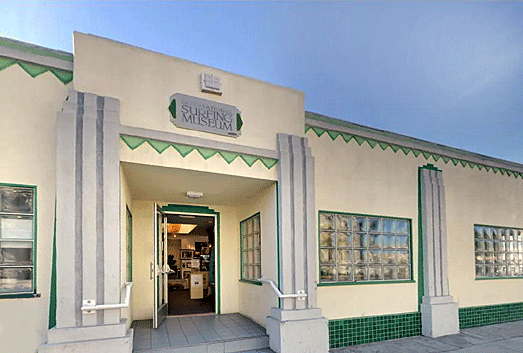
From the early 1930s to the late 1940s, Huntington Beach locals created
a lifestyle around surfing. This was in part due to lighter Bolsa wood
surfboards, but also to the interest of returning soldiers and sailors
who discovered surfing in the South Pacific. It wasn’t until 1948
through 1959 that surfing brought on an era of beach parties, Woodies,
and Gidget. Originally only a summer sport, the invention of the rubber
wetsuit allowed surfing to become possible year-round and surfers
followed the waves around the globe.
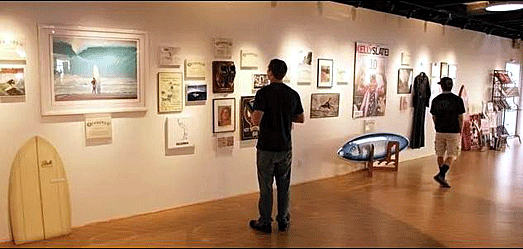
The bronze full size likeness of the Duke Paoa Kahininu Makoe Hulikohoa
Kahanamoku has become a Huntington Beach landmark. The Polynesian giant
and bold medal Olympic swimmer became known as the Father of Modern
Surfing, winning over five United States Surfing Championships in
Huntington Beach. .
In 1956. Gordie Duane opened Huntington Beach’s first surfboard shaping
shop under the pier. And the following years, Jack Hokanson, opened
Jack’s Surfboards, creating the start of an industry. The Museum's gift
shop is also called the "Surf Shop."
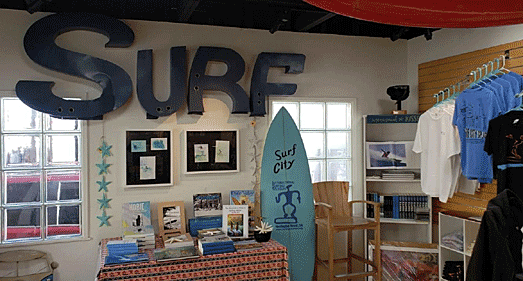
Located on the main thoroughfare of Huntington Beach, the Museum,
founded by Canadian Natalie Kotsch who had never surfed, opened in July
of 1987, and has welcomed visitors from over 42 countries.
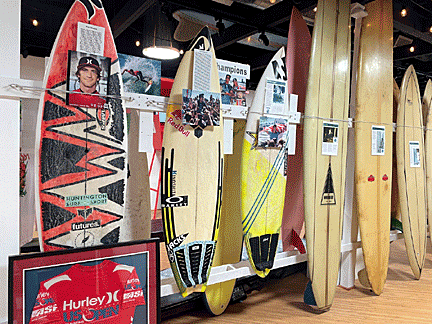 Dedicated
to preserving the past, participating in the present, and influencing
the future of all aspects of surfing culture worldwide, the Museum
houses collections of surfing memorabilia and culture including some of
surfing history's most significant artifacts such as Duke Kahanamoku's
surfboard and the Guinness World Records breaking World's Largest
Surfboard. Because the Museum’s space is small, it has to rotate its
vast collection. Visitors can learn how surfing as both a sport and
culture became what it is today. Dedicated
to preserving the past, participating in the present, and influencing
the future of all aspects of surfing culture worldwide, the Museum
houses collections of surfing memorabilia and culture including some of
surfing history's most significant artifacts such as Duke Kahanamoku's
surfboard and the Guinness World Records breaking World's Largest
Surfboard. Because the Museum’s space is small, it has to rotate its
vast collection. Visitors can learn how surfing as both a sport and
culture became what it is today.
Among the
items in its collection are notable surfing artifacts, including the
World’s Largest Surfboard, historic photos, Dick Dale’s guitar, clothes
and boards from Kelly Slater, Bruce Brown’s camera that he used to film
“Endless Summer,” vintage posters, and special exhibits throughout the
year. Visitors can catch surfing’s cool vibe and laid back style, as
well as seeing where the phenomenon began.

The Museum’s main room has displays of surfing memorabilia, including
everything from original wooden boards to pieces of the old pier and
stones from the Huntington Beach surfing walk of fame. A small theater
in the back shows various surfing movies and history for visitors to sit
and enjoy. The Largest Surfboard is also on display here.
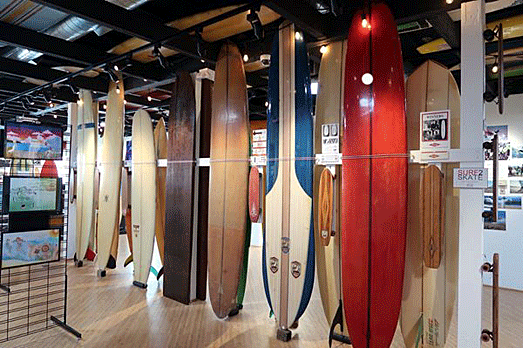
The last area of the museum displays a number of unique pieces, such as
a surfboard painted with the “Last Supper” and a full-size replica of
what looks like the Silver Surfer. There’s also a wall dedicated to
surfing music, including a collection of show flyers from over the
years.

While the museum is small, it captures the style and culture of the
sport, along with the innovators who made it what it is today.
<
Back to More Antiques to View
Next Article >
|
